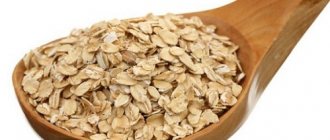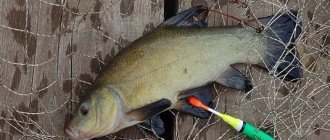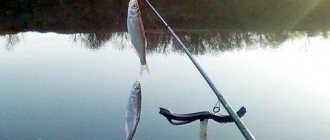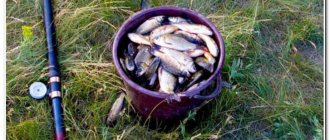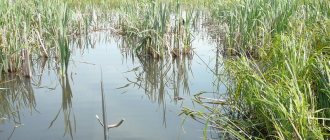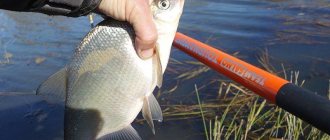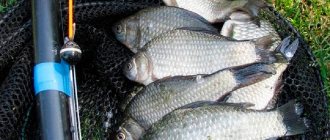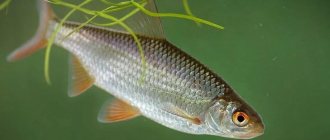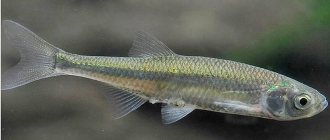Mountain fishing.
High water in the Amur and its tributaries, flooded banks. Impression, there are no fish here. It would seem that you can give up on fishing... I suggest you discover an alternative - fishing on mountain taiga rivers. If this is your first experience, then you will discover the wonderful world of the Far Eastern taiga, crystal clear waters and the rather peculiar inhabitants of these waters. October is perhaps the most suitable time for such fishing, since it is during this period that fishing becomes easier, more confident, and does not require much knowledge in this area.
It is in October that the so-called fish migration occurs. What does it mean? Fish do not winter in the upper reaches of rivers, since they often freeze and there is no constant influx of fresh, oxygen-bearing water. Grayling and lenok live in mountain rivers; unlike Amur fish, they cannot live in water with a low oxygen content. And they will not fall asleep, unlike, again, Amur fish. Accordingly, with the arrival of low temperatures (September - October), snow often already falls in the mountains, many places in the rivers are intercepted by ice, the water level drops, there is also little food, and the fish begin to roll into wintering pits (these are the deeper parts of the rivers, where freezing and often there are underground springs that bring oxygen; aquatic benthos remains here - nutrients).
What do we need? The minimum fisherman's kit for fishing on a mountain river includes the following components. Wading boots or a wading suit (overalls), made of rubberized fabric, or specially treated nylon, that is, from so-called non-breathable materials that do not allow water to pass through and allow you to move in the water. Since this type of fishing is called wading: you are at least ankle-deep in water, and at most waist-deep. Boots on the Khabarovsk market cost from 900 rubles, a wading suit from 2,500 rubles.
Disadvantages of such a suit.
- All the heat, all the moisture that your body releases when you move remains in your suit. Consequently, the clothes get a little wet from the inside, and therefore you may freeze.
- Weight of overalls.
- The sole of the boots of the overalls, although corrugated, is still quite slippery. It’s just designed to move through silt, mud, and you will move over stones with a coating of algae.
Waders
So be careful! There is an alternative. You can purchase a specialized wading suit, waders, which are made from two types of fabric - gore-tex (breathable) or neoprene (foam rubber sandwiched between two layers of fabric), similar materials are used in diving suits. There are two types of waders: those immediately equipped with boots, or those with wading boots included separately. These suits are specialized in mountain fishing - the soles of their shoes are made of artificial felt, which does not slip when walking, it does not rot and is not afraid of water. It’s much more comfortable to walk around while fishing in this outfit!
The price of waders with boots (made of neoprene) is from 3,500 rubles. Waders for boots (made of gore-tex material) - from 4,500 rubles. Boots with felt soles - from 3,000 rubles.
The next thing you will need is a fishing rod. The fishing rods used are quite specific. How are they different? Firstly, it's lightness. After all, the fishing rod is in your hand during the entire fishing period. Secondly, it is compact. If we are in open areas and don’t move around much, the compactness of the fishing rod is not so important for us. But there are times when we need to move along the river bank or along the river itself, often littered with fallen trees (the so-called windbreaks), and then compactness is extremely important.
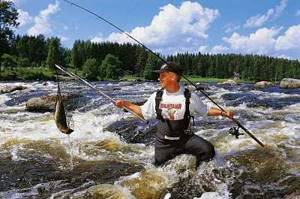
Fishing rod
If your fishing rod is long, it will be very awkward for you to move around with it. Therefore, the recommended length (for example, for rivers like the Khor or Anyui) is from 3.5 to 5 meters. In addition, the fishing rod should be quite rigid in action (the fishing rod that you used to catch the same crucian carp will not work). I advise you to inquire further about the specifics and differences between these two types of fishing rods from the consultants of specialized stores.
The next point is kan (aka haryuzyatnitsa, box). This is a small container that you carry with you and put caught fish there. It is inconvenient to return to the shore all the time to leave the fish there, or it is inconvenient to carry a fish tank with you. This could be a wicker basket of a specific configuration, a plastic box, or, as a last resort, some use a cut-off rectangular plastic canister. When there is nothing else to replace it with, they even use plastic bags.
Equipment. Again, it's a little different. Floats are used with a medium load capacity (from 3 to 8 g), usually round or oval in shape, without long antennas, with one end weight, from which there is usually an attached leash with a hook. Ask consultants in city stores about equipment options (you need clarity here).
You can go mountain fishing and spinning. The only thing is that you don’t need to use a long one (the rivers are not that wide). The usual length of a spinning rod for mountain fishing is 2.1-2.4 m, according to the test - from 5 to 45 g, with a fast action. Among the baits are spinners (according to the accepted size of bluefox 3, 4 - if we are working on lenka and 5 - if we are working on taimen), wobblers (with medium and small depth, the shape of which is mainly “minou” and “gobies”). But, believe me, getting to know mountain fishing is more interesting with a fishing rod! This option is much more exciting and productive. Spinning still has specifics that you need to learn from more experienced fishermen, or gain your own experience. The fishing rod is much simpler in this regard.
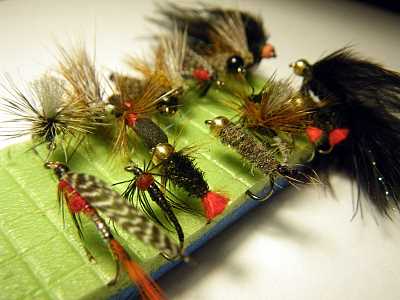
Bait
Bait. Artificial baits are used. They are called differently: chemistry, flies, jigs, etc. This is an imitation of aquatic insects made using natural and synthetic materials. These baits have a wide variety of shapes and colors; in almost all specialized stores in the city they are presented in a fairly large assortment.
Since we will be fishing in the fall, flies of various orange (from dark terracotta to bright, chemical), green (from dim khaki to dark marsh) colors are suitable. I can advise. It makes no sense to take one fly. It is very difficult to guess which fly will work. Experienced fishermen go fishing with sets of up to a thousand pieces. It is clear that you will not immediately acquire such a collection. The minimum set you will need for the first time is 10-15 pieces. Prices: from 25 rubles for a factory-made bait, up to 140 rubles for a hand-knitted one by a famous craftsman. Today - just briefly about what is necessary. Well, in the next issue we will tell you about fishing techniques and fishing mountain rivers in our region.
Rod
If you are going to fish from a cultivated embankment that closes the lower reaches of the river into a strictly defined channel, then feel free to arm yourself with a 4-5 meter “swing” with a connector at the tip. Longer rods, as a rule, are inconvenient in terms of maneuverability, given the factor that local anglers may be standing with you, at a distance of 20-30 cm. Questions with the company that produces the fly rod, as well as its price, for fishing, I think , have no relationship. In addition, under the embankments, deep holes located 1.0-1.5 m from the parapet are often washed out by the river. It is clear that with a 6-7 meter “swing” it will be difficult to catch fish in such a peculiar place.
But if you decide to fish in a “swing”, from the coastal pebbles, at the very edge of the confluence of the river and the sea, then I advise you to take a 6-7 meter “swing”, since you will have to “reach” to a relatively deep place (1.5- 2.0 meters) and hide from the extremely shy carp or mullet. The question of installing the float, namely whether the equipment should be sliding or blind, should be decided by you, depending on your preferences. Personally, I like blind rigging, as it is more sensitive to the bites of bottom fish in relatively strong currents of a mountain river. The load capacity of the float should not exceed 1.5 grams, otherwise the carp, barbel and podust will carefully remove the bait from the hook, but you will not notice it.
Gear for catching grayling from the surface
In the spring, when the mass emergence of insects begins, you can begin to select gear that will be used for fishing from the surface of the reservoir. The choice of bait for fishing is carried out individually; artificial dry flies are mainly used. Their choice is made based on the type and type of insect that grayling feeds on in a particular period.
There are several options for fishing from the surface, each involving the use of a certain type of gear. In the first case, anglers use a fly fishing rod, which is equipped with a light reel on which a conical cord is wound. Note that the presence of high-quality tackle is not enough; in addition, you will need a large set of flies that are different not only in shape, size, but also in color.
Read: Fishing in the Urals
Fly fishing is difficult; not every angler manages to master the casting technique. Therefore, a larger percentage opts for a float rod, which is modified specifically for this method of fishing. All that is required is to remove the weight from the rig. A fishing rod is selected with a length of 2.1-3 meters, a reel with a front clutch is installed on the tackle, onto which a fishing line with a cross-section of 0.16 mm is wound, a leash 0.12 mm long is required, to which a hook No. 3-4 is tied. The float is selected with a minimum carrying capacity; it is advisable to use the usual version without bright colors. This type of fishing uses ordinary insects, which can easily be caught on the river bank.
Main types of bait for fishing grayling
The range of baits for catching grayling is amazing in its diversity. In addition to artificial flies of various shapes and sizes, grayling fishing is successfully carried out using small rotating spoons.
Many experienced fishermen especially highlight the Comet black Fury spoon produced by the famous company Mepps. In addition, grayling is also caught with oscillating spinners with a narrow body weighing up to 6 grams.
If you plan to catch grayling with a wobbler, then you should purchase models that are used for chub fishing. An excellent option would be the Smith D-Contact 50 model. All of these artificial baits are used if fishing is carried out using a spinning rod. When fishing with a wire or float tackle, you can attach bloodworms, pieces of dung worm, as well as insects that live near the pond to the hook.
Subscribe to
our channel in Yandex Zen
Selecting tackle for line fishing
To conveniently catch grayling using this method, you should buy rods more responsibly, you need to pay special attention to the type of gear and length. It is recommended to consider models with guide rings; a reel must be installed on the fishing rod; it must be purchased with a minimum weight, preferably with a front drag and a spool size of 2,000. Lines with a minimum cross-section should be wound on the reel; note that the thinner it is, the greater the chances of catching a cautious predator. Experienced fishermen advise using a fishing line with a diameter of 0.16 mm as the main one, but in this case you will need to use a leash made of fishing line, for example, with a cross-section of 0.12 mm, the length of which will be in the range of 1-1.5 meters.
Read: Grayling fishing in autumn
The equipment includes a float; it is recommended to choose foam products with a load capacity of up to three millimeters. It is not recommended to use models painted in bright shades; such a float, especially when fishing at shallow depths, will alert the fish.
When fishing for grayling, various types of bait of animal origin are used, however, during the period of mass emergence of insects, you can try to catch the predator using dry flies. Experienced fishermen advise feeding the place chosen for fishing; in addition, during the fishing process, throwing small portions of food into the water, this will attract predators to the area where fishing is taking place.
